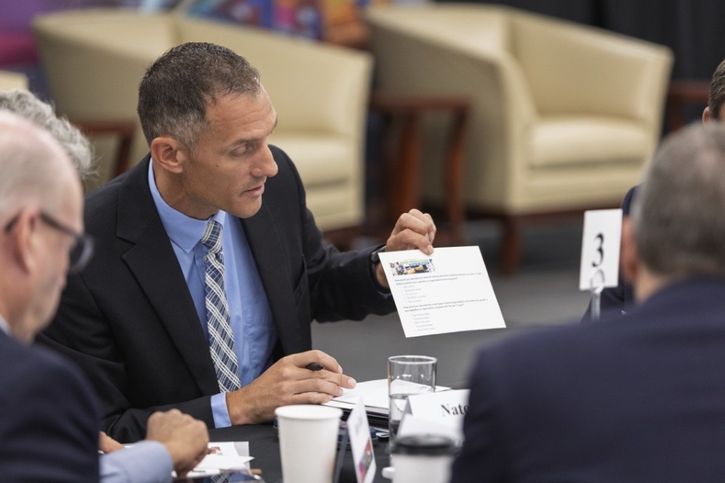In June, the Kansas City Fed’s Omaha Branch hosted its Food and Agriculture Economic Summit. This year’s event, themed “Investment in Food Production and Distribution,” was an opportunity for Bank leaders to engage with food and ag industry professionals to gain insight and understanding of what’s happening on the ground in the sector. Nate Kauffman, Omaha Branch Executive, said conversations that came from the events were extremely valuable to the Bank.
“We understand that, while we can learn from data, there are often a lot of things that surface through conversations with businesses that give us the sense that we need to go back to the data to better understand it,” Kauffman said.

Omaha Branch Executive Nate Kauffman explains discussion topics during an event breakout.
The event kicked off June 24 with remarks from Kansas City Fed President and CEO Jeff Schmid. In addition to dozens of industry representatives, including farmers, food distributers and ag bankers, Federal Reserve Gov. Michael Barr was also in attendance.
“This event continues our tradition of bringing together leaders in agricultural and food industries to share insights and keep the Bank up to date on the current conversation in the sector,” said Schmid in his remarks. “At the Kansas City Fed we are invested in understanding agricultural and food markets and making sure that we communicate that understanding to a larger audience.”

Kansas City Fed Senior Economist Francisco Scott takes notes during a breakout session.
With plenty of time for questions and group discussions, the event’s programming included sessions on investments in farm production and investment drivers in food consumption and distribution. Other major themes discussed included:
- Economic and demographic trends in rural areas are headwinds for some businesses and have also shaped investment.
- Artificial intelligence and other emerging technologies are being utilized as opportunities to improve efficiency and productivity throughout the supply chain and solve labor-related challenges.
- Consumer trends remain a primary factor in investment decisions across the food and ag sector.
- Growth of agricultural production in South America and other regions has influenced long-term strategies for agricultural producers and agribusinesses.
- Policy uncertainty, labor availability, high costs of capital and limited rural infrastructure have led to new investments focused on efficiency rather than growth.
Kauffman said the Bank specifically designed the program to allow for a broad range of topics to emerge.
“I think some of the ideas and comments that have surfaced, they might be things we want to revisit six to 12 months from now,” Kauffman said. “Others are things that are going to be on our long-term radar for quite some time.”

Kansas City Fed Economist Ayesha Cooray discusses agriculture with event attendees.
Agriculture and the Kansas City Fed
The Kansas City Fed is strongly connected to agriculture, from farm production and food manufacturing to agricultural banking and finance. Because the industry is vital to the seven states that make up the 10th District, the Kansas City Fed is committed to understanding developments in the agricultural economy and gathering perspectives from rural America to include them in discussions on the national economy.
In addition to hosting the Food and Agriculture Economic Summit, the Bank maintains a pulse on the ag economy by regularly collecting and distributing data, analyzing insights and connecting with industry professionals.
Interested in learning more?
Explore our Agriculture connection on our website or subscribe to industry-specific emails from the Kansas City Fed to get the latest data right to your inbox.
Other Kansas City Fed Ag resources include:
Find articles summarizing recent developments in agricultural finance and lending.
The quarterly Ag Credit Survey provides current indicators of the financial performance of Tenth District agriculture.
Review the latest Ag Bulletin for a summary of ag conditions and additional outlook articles on the ag economy.
The views expressed are those of the authors and do not necessarily reflect the positions of the Federal Reserve Bank of Kansas City or the Federal Reserve System.
